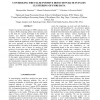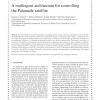640 search results - page 19 / 128 » Access Control for Active Spaces |
ISBI
2004
IEEE
14 years 9 months ago
2004
IEEE
Despite its potential advantages for fMRI analysis, fuzzy C-means (FCM) clustering suffers from limitations such as the need for a priori knowledge of the number of clusters, and ...
WIAS
2010
13 years 7 months ago
2010
The fundamental role of autonomous agents in managing activities of space systems has emerged some years ago with the NASA’s Remote Agent Experiment. However, the possible advant...
ITC
1997
IEEE
14 years 28 days ago
1997
IEEE
Testing embedded cores is a challenge because access to core I/Os is limited. The user-defined logic (ZJDL) surrounding the core may restrict the set of test vectors that can be a...
JSAC
2011
12 years 11 months ago
2011
—Several contention-based Medium Access Control (MAC) protocols have been proposed for the vehicles to gain the radio channels to distribute active safety messages timely, e.g., ...
BNCOD
2003
13 years 10 months ago
2003
The event-condition-action paradigm (also known as triggers or rules) gives a database “active” capabilities – the ability to react automatically to changes in the database o...


